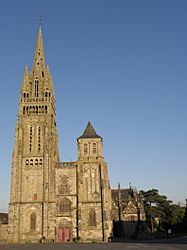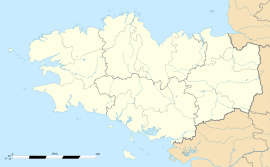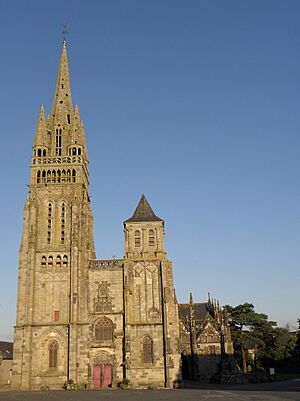Le Folgoët facts for kids
Quick facts for kids
Le Folgoët
Ar Folgoad
|
||
|---|---|---|

The basilica of Notre-Dame du Folgoët
|
||
|
||
| Country | France | |
| Region | Brittany | |
| Department | Finistère | |
| Arrondissement | Brest | |
| Canton | Lesneven | |
| Intercommunality | Pays de Lesneven et de la Côte des Légendes | |
| Area
1
|
9.77 km2 (3.77 sq mi) | |
| Population
(Jan. 2019)
|
3,215 | |
| • Density | 329.07/km2 (852.3/sq mi) | |
| Time zone | UTC+01:00 (CET) | |
| • Summer (DST) | UTC+02:00 (CEST) | |
| INSEE/Postal code |
29055 /29260
|
|
| 1 French Land Register data, which excludes lakes, ponds, glaciers > 1 km2 (0.386 sq mi or 247 acres) and river estuaries. | ||
Le Folgoët (which means "the fool's beech grove" in Breton, Ar Folgoad) is a small town in the northwest of France. It is located in the Finistère department, which is part of the Brittany region. This area is known for its beautiful coastline and rich history. Le Folgoët is a commune, which is like a local administrative area or municipality in France.
Contents
Exploring Le Folgoët
Le Folgoët is a charming commune with a population of about 3,200 people. It covers an area of nearly 10 square kilometers (about 3.8 square miles). The town is part of the Brest arrondissement and the Lesneven canton. It is also part of the Pays de Lesneven et de la Côte des Légendes, which is a group of towns working together in the region.
The Famous Basilica
The most famous building in Le Folgoët is the Basilica of Notre-Dame du Folgoët. This impressive church is a major landmark and draws many visitors. It is known for its beautiful Gothic architecture, which is a style of building popular in Europe during the Middle Ages. The basilica was built between the 14th and 15th centuries.
History of the Basilica
The basilica's story began with a man named Salaün, who was considered a simple or "foolish" person. He was known for saying only "Ave Maria" (Hail Mary). After he died, a lily grew from his grave, and on its petals, the words "Ave Maria" were written in gold. This was seen as a miracle, and a chapel was built on the site. Over time, this chapel grew into the grand basilica we see today.
Architecture and Design
The Basilica of Notre-Dame du Folgoët is famous for its detailed carvings and unique features. It has a beautiful bell tower and intricate stone work. Inside, you can find stunning stained-glass windows and altars. The basilica is a great example of Breton religious art and history.
Local Life and Culture
Life in Le Folgoët is peaceful, with a strong connection to Breton culture. The Breton language, Brezhoneg, is still spoken by some people in the region. The town often hosts local events and festivals that celebrate its heritage. These events can include traditional music, dances, and food.
Economy and Community
The economy of Le Folgoët is mainly based on agriculture and local businesses. Many people also work in nearby larger towns. The community is close-knit, and residents often participate in local activities and support each other. The town provides essential services for its citizens, including schools and shops.
Getting Around Le Folgoët
Le Folgoët is well-connected to other towns in Finistère. You can reach it by car, and it's not far from the city of Brest, which has a larger train station and airport. This makes it easy for people to visit the basilica and explore the surrounding area of Brittany.
See also
 In Spanish: Le Folgoët para niños
In Spanish: Le Folgoët para niños





